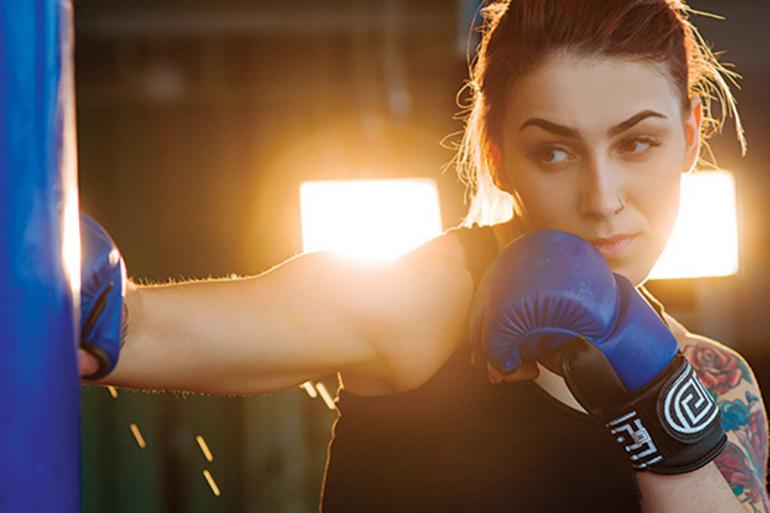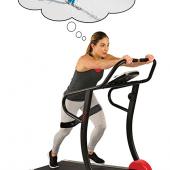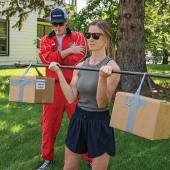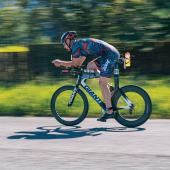Crazed & Infused
New fitness trends invigorate Bozeman’s workout scene.
Used to be, if you wanted to whip yourself into shape, you went for a hike or run before work and hit the gym after, to pump iron, spin on the stationary bike, and otherwise indulge in what amounted to the same old indoor routine. Sure, CrossFit, yoga, Pilates, and a few other methodologies have broadened our inside-exercise horizons of late; but by and large, the Bozeman fitness scene has long mimicked our food-and-beverage scene: perfectly fine, but nothing to write home about.
But this town she is a-changin’, and with all these new folks come new ideas—namely, the ways in which we get fit indoors. Like restaurants and breweries (hmm… coincidence?), a whole new crop of gyms, studios, and other temples of taut have opened up, with a whole new set of ways to work out. From kickboxing to obstacle courses, complicated machines to regimented group training, it seems there’s a system for everyone nowadays. Which is great—the fitter everybody else is, the more it makes us want to keep our own lazy asses in shape.
Which is why we sent four of our writers out and about, to try a few of the newer items on the exercise menu. Here’s what they found out.
Embrace the Change
It’s not uncommon for mountain athletes to bike the same trails, climb the same routes, and run the same loops. We’re creatures of habit, and sometimes, the less we have to plan, the better. But this approach can lead to plateaus, repetitive-use injuries, and a general lack of motivation.
In the spirit of keeping things fresh, I embraced the challenge of changing my daily workout program. I was committed to a high-intensity regimen that matched the requirements for a trail run or an intense mountain-bike ride, but I needed to get knocked out of my comfort zone, and maybe slow down a bit. While I didn’t want to leave the particular community I’d grown close to, I knew that I needed to push myself with a change.
A friend suggested the Helse Lagree fitness studio, a new type of workout that had just come to Bozeman. I went for the first time knowing that I’d enjoy the intensity, yet also understanding that I’d never experienced anything like this before. The workout is on a personal device called the Megaformer, which includes spring resistance, a moving platform, and straps connecting to cables. The giant black machine was daunting to say the least; however, the instructor demonstrated how easy it was to get accustomed to, and led the class in a way that I understood.
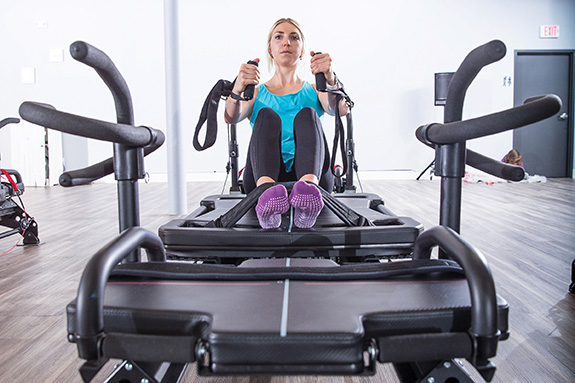
In general, we’re used to results that come from fast movements, but in the case of Lagree, the slower you go, the faster you gain. This was hard to conceive as it runs counter to all my competitive instincts—I’m more of the hare than the tortoise. Slow movements might sound easy, but the workouts pushed me to the limit. Sweat beads ran into my eyes and onto the floor within the first three minutes. As my legs started to shake, I knew that I’d found something that was going to challenge my strength, endurance, and flexibility. The 45-minute class flew by and by the end, I was worked.
At this time in my life, converting to a new workout has been worth it because I needed to shake things up, like the trail runner who switches from morning M laps to longer runs up Blackmore. I found something that supports my outdoor lifestyle and has given me confidence to continue to change and grow. The intense focus required on the Megaformer translates well to the concentration needed on long hill climbs—you aren’t moving fast, but your whole body and mind are engaged, and that’s what keeps you moving forward. —Callie Glanzer
Karate Kid
Over the past few years, kickboxing has seen a resurgence as a cardio-based workout: High Intensity Interval Training (HIIT) combined with basic kickboxing strikes. 9Round in downtown Bozeman brings this rebirth home. A kickboxing workout burns massive amounts of calories in a short amount of time, so it’s a great way to get your heart rate elevated on days you can’t find time for a trail run or bike ride. Striking is also a major stress reliever, for when that deadline has come and gone and the next is rapidly approaching.
The 9Round structure will be familiar to anyone who has done a HIIT-type workout, such as CrossFit. It’s 30 minutes, consisting of nine three-minute rounds at high-intensity stations followed by short “active rests,” which could be squats, a wall-sit, or lunges. These active rests approximate the strain of steep hill climbs, when your heart is pumping and your legs are throbbing, even though you’re only taking small steps.
Because spring is a busy time for me, the 9Round program seemed perfect. Their setup is different than other gyms in that there are no set class times. Members walk in at any point during open hours, and a trainer is on site to walk you through the day’s workout. You could be the only person in the gym, or you might be staggered through different stations with other people. I walked into my first workout fairly cocky, believing my own base fitness and minor experience with kickboxing to be more than adequate for a 30-minute workout. Within the first two stations, I was gasping and wheezing and my legs were shaking—I felt like I’d just sprinted the M for the first time.
The seconds dragged by during the most challenging stations, but before I knew it, the timer was going off, I was crying through a wall sit, and then it was on to the next station. The 30 minutes went by both excruciatingly slow and insanely fast, and I felt accomplished and exhausted, swore to never return, then found myself back there a few days later. Endorphins have a way of doing that, as many trail runners know.
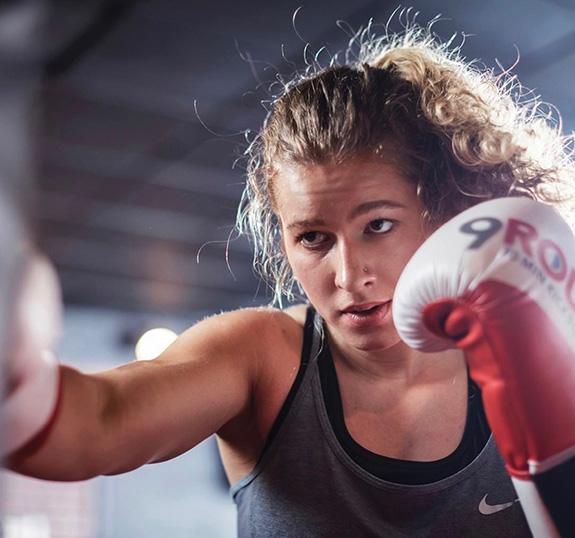
Participants are lightly instructed on striking and kicking form, but there is no extended formal training before the workout starts. The footwork will be helpful dodging rocks and roots on Middle Cottonwood in June, and the side-to-side movements help with core strengthening and agility, something that has always plagued my on-trail training.
After several sessions, I found my strength and cardio increasing, and could see that improvement translating into better performance come summer trail-running season. While I prefer to run outside, 9Round is a great substitute when time is short, and it fine-tunes movements that are hard to duplicate with road running. —Maggie Slepian
Neutral Ground
“Do you want to become a stronger trail runner?”
That was one of the first questions Will Caton asked as I toured his gym, Swiss Fit Montana. My answer was “hell yes,” but I was skeptical. Swiss Fit is not a typical gym; it utilizes the Power Plate, a piece of training equipment that focuses on vibration technology (not unlike a certain infomercial fitness product; understand my skepticism?) to build strength and balance. But listening to Will explain the process—and more importantly, seeing his passion—erased my doubts and I was soon signed up.
At Swiss Fit, you primarily train one-on-one with Will. You discuss personal goals and Will develops a training regime based on those goals, your current fitness level, and additional needed adjustments. My goal was to not feel like I’d been hit by a truck at the completion of the Bridger Ridge Run, which had happened the previous year. The workouts are 30 minutes, with Will making sure you do each exercise correctly for maximum benefit. Most exercises range from 30 to 60 seconds, and you do two to three sets of each. Sounds simple, right?
Few times in my life have I been as sore as I was following my first week of Swiss Fit training. I wasn’t starting from scratch, either; it was just that I had focused on running. This workout targeted my entire body. I’d like to say that the following weeks were significantly better, but as one area would begin to loosen, Will shifted focus to another group of muscles. The soreness lessened as the weeks progressed, but, even now, I can leave a workout and be sore the following day. It’s always a good soreness, though, the kind that lets you know you’re building something.
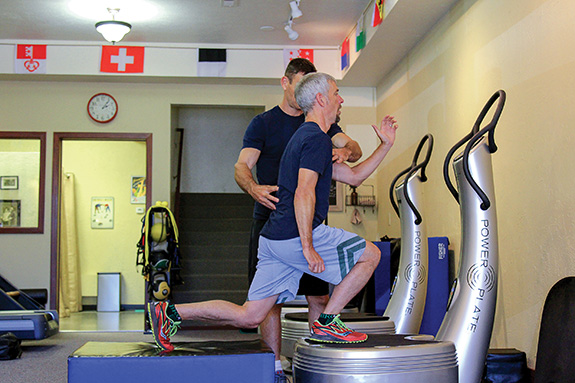
As I progressed through training, there was a consistency to what muscles we worked on and why. Will focused on my quads, glutes, and abs. Quad strength would help on the repetitive downhill run, while strong glutes would blast me up the hill. Trail running, with all the twists, turns, and switchbacks, requires a strong core, conditioned to twisting and helping the legs drive. The workout always varied, but the focus remained.
Another project (that is still ongoing) was my posture. Years of deskwork had created a slouch that’s pronounced while running, especially when I get tired. The more I hunch over, the more energy my body requires to propel uphill, making me hunch over even more, a vicious cycle that, although not fully corrected, has been greatly improved. This is something that I was unaware of and it would never have been corrected without Swiss Fit and the watchful eye of Will Caton. —Chris McCarthy
In My Prime
Ever find out you’ve been doing something wrong your entire life? That’s what happened to me, my first day at Prime Performance & Physio, a new facility in Four Corners that combines physical therapy with strength training. It’s basically a PT clinic with an in-house gym—an immaculate one, with top-notch equipment and some serious weightlifters—and it seemed like just what my aging, injury-laden body needed as I began my winter fitness regimen.
Dropping into a deep squat, I felt that familiar pain in my lower back—the same pain that had prevented me from putting up any real weight in a long time. So long, in fact, that I thought my heavy-lifting days were over—and with it, the raw physical strength I’d enjoyed for most of my life, and which served as an invaluable aid in the outdoors, for both athletic performance and injury prevention.
After ten reps, Justin, a Prime trainer, had seen everything he needed to see. He gave me three tips to improve my form. I followed his advice—no pain. I added more weight. No pain. Still more weight, and still no pain.
Dumbfounded, I plied Justin with questions. His answers revealed a complex understanding of physiology and body mechanics. Ultimately, what I learned was that slight adjustments to posture help optimize movement, properly loading certain parts of the body and removing undue stress on others. By correcting my form, I’d shifted the burden off my back and onto my legs, where it belonged.
And just like that, I was back in action. The next two months found me at Prime two to three days each week, making measurable gains every time. With Justin’s help, I added bench-press and deadlifts to my pain-free powerlifting routine. I also availed myself of Prime’s group fitness classes, which left my heart pumping, my lungs heaving, and my legs loaded with lactic acid. I pushed myself, hard, to get my old body back—and it felt good, so good.
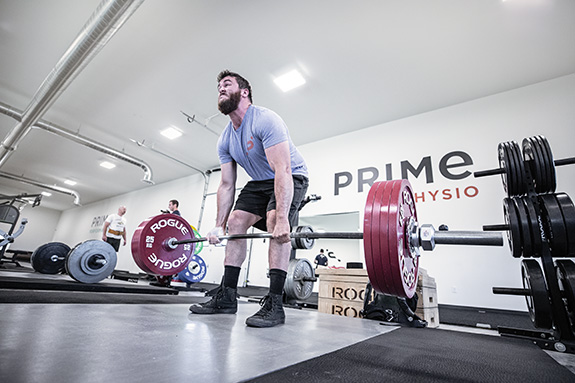
With my restored strength came renewed vigor, leading to faster hikes and longer bursts on uphill runs. More importantly, though, I balanced my body—without realizing it, I’d been favoring one leg for years, and the misalignment caused my back to hurt on longer outings. The strict, heavy lifts forced equal participation by both legs, re-aligning my hips and relieving the strain on my back.
And now, with spring upon us, I can’t stop. I walk into the gym, greeted by smiles from the folks I’ve gotten to know there. I look around the wide-open, well-lit space and watch them work to improve themselves. As I load up the bar and join in the struggle, I see a better, stronger version of myself. I see a better season ahead. I see a long summer of riding steep trails, running fast rivers, and climbing tall mountains. In short: a summer of strength. —Mike England


